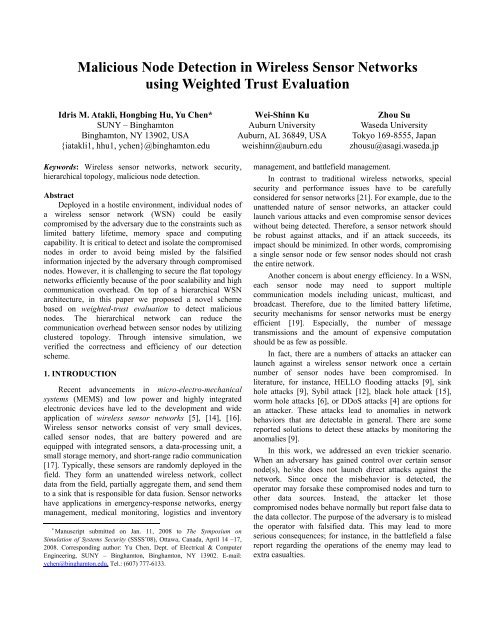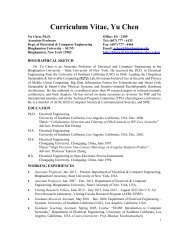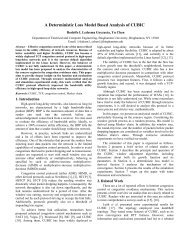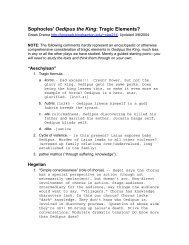Malicious Node Detection in Wireless Sensor Networks using ...
Malicious Node Detection in Wireless Sensor Networks using ...
Malicious Node Detection in Wireless Sensor Networks using ...
You also want an ePaper? Increase the reach of your titles
YUMPU automatically turns print PDFs into web optimized ePapers that Google loves.
<strong>Malicious</strong> <strong>Node</strong> <strong>Detection</strong> <strong>in</strong> <strong>Wireless</strong> <strong>Sensor</strong> <strong>Networks</strong><br />
us<strong>in</strong>g Weighted Trust Evaluation<br />
Idris M. Atakli, Hongb<strong>in</strong>g Hu, Yu Chen*<br />
SUNY – B<strong>in</strong>ghamton<br />
B<strong>in</strong>ghamton, NY 13902, USA<br />
{iatakli1, hhu1, ychen}@b<strong>in</strong>ghamton.edu<br />
Wei-Sh<strong>in</strong>n Ku<br />
Auburn University<br />
Auburn, AL 36849, USA<br />
weish<strong>in</strong>n@auburn.edu<br />
Zhou Su<br />
Waseda University<br />
Tokyo 169-8555, Japan<br />
zhousu@asagi.waseda.jp<br />
Keywords: <strong>Wireless</strong> sensor networks, network security,<br />
hierarchical topology, malicious node detection.<br />
Abstract ∗<br />
Deployed <strong>in</strong> a hostile environment, <strong>in</strong>dividual nodes of<br />
a wireless sensor network (WSN) could be easily<br />
compromised by the adversary due to the constra<strong>in</strong>ts such as<br />
limited battery lifetime, memory space and comput<strong>in</strong>g<br />
capability. It is critical to detect and isolate the compromised<br />
nodes <strong>in</strong> order to avoid be<strong>in</strong>g misled by the falsified<br />
<strong>in</strong>formation <strong>in</strong>jected by the adversary through compromised<br />
nodes. However, it is challeng<strong>in</strong>g to secure the flat topology<br />
networks efficiently because of the poor scalability and high<br />
communication overhead. On top of a hierarchical WSN<br />
architecture, <strong>in</strong> this paper we proposed a novel scheme<br />
based on weighted-trust evaluation to detect malicious<br />
nodes. The hierarchical network can reduce the<br />
communication overhead between sensor nodes by utiliz<strong>in</strong>g<br />
clustered topology. Through <strong>in</strong>tensive simulation, we<br />
verified the correctness and efficiency of our detection<br />
scheme.<br />
1. INTRODUCTION<br />
Recent advancements <strong>in</strong> micro-electro-mechanical<br />
systems (MEMS) and low power and highly <strong>in</strong>tegrated<br />
electronic devices have led to the development and wide<br />
application of wireless sensor networks [5], [14], [16].<br />
<strong>Wireless</strong> sensor networks consist of very small devices,<br />
called sensor nodes, that are battery powered and are<br />
equipped with <strong>in</strong>tegrated sensors, a data-process<strong>in</strong>g unit, a<br />
small storage memory, and short-range radio communication<br />
[17]. Typically, these sensors are randomly deployed <strong>in</strong> the<br />
field. They form an unattended wireless network, collect<br />
data from the field, partially aggregate them, and send them<br />
to a s<strong>in</strong>k that is responsible for data fusion. <strong>Sensor</strong> networks<br />
have applications <strong>in</strong> emergency-response networks, energy<br />
management, medical monitor<strong>in</strong>g, logistics and <strong>in</strong>ventory<br />
∗<br />
Manuscript submitted on Jan. 11, 2008 to The Symposium on<br />
Simulation of Systems Security (SSSS’08), Ottawa, Canada, April 14 –17,<br />
2008. Correspond<strong>in</strong>g author: Yu Chen, Dept. of Electrical & Computer<br />
Eng<strong>in</strong>eer<strong>in</strong>g, SUNY – B<strong>in</strong>ghamton, B<strong>in</strong>ghamton, NY 13902. E-mail:<br />
ychen@b<strong>in</strong>ghamton.edu, Tel.: (607) 777-6133.<br />
management, and battlefield management.<br />
In contrast to traditional wireless networks, special<br />
security and performance issues have to be carefully<br />
considered for sensor networks [21]. For example, due to the<br />
unattended nature of sensor networks, an attacker could<br />
launch various attacks and even compromise sensor devices<br />
without be<strong>in</strong>g detected. Therefore, a sensor network should<br />
be robust aga<strong>in</strong>st attacks, and if an attack succeeds, its<br />
impact should be m<strong>in</strong>imized. In other words, compromis<strong>in</strong>g<br />
a s<strong>in</strong>gle sensor node or few sensor nodes should not crash<br />
the entire network.<br />
Another concern is about energy efficiency. In a WSN,<br />
each sensor node may need to support multiple<br />
communication models <strong>in</strong>clud<strong>in</strong>g unicast, multicast, and<br />
broadcast. Therefore, due to the limited battery lifetime,<br />
security mechanisms for sensor networks must be energy<br />
efficient [19]. Especially, the number of message<br />
transmissions and the amount of expensive computation<br />
should be as few as possible.<br />
In fact, there are a numbers of attacks an attacker can<br />
launch aga<strong>in</strong>st a wireless sensor network once a certa<strong>in</strong><br />
number of sensor nodes have been compromised. In<br />
literature, for <strong>in</strong>stance, HELLO flood<strong>in</strong>g attacks [9], s<strong>in</strong>k<br />
hole attacks [9], Sybil attack [12], black hole attack [15],<br />
worm hole attacks [6], or DDoS attacks [4] are options for<br />
an attacker. These attacks lead to anomalies <strong>in</strong> network<br />
behaviors that are detectable <strong>in</strong> general. There are some<br />
reported solutions to detect these attacks by monitor<strong>in</strong>g the<br />
anomalies [9].<br />
In this work, we addressed an even trickier scenario.<br />
When an adversary has ga<strong>in</strong>ed control over certa<strong>in</strong> sensor<br />
node(s), he/she does not launch direct attacks aga<strong>in</strong>st the<br />
network. S<strong>in</strong>ce once the misbehavior is detected, the<br />
operator may forsake these compromised nodes and turn to<br />
other data sources. Instead, the attacker let those<br />
compromised nodes behave normally but report false data to<br />
the data collector. The purpose of the adversary is to mislead<br />
the operator with falsified data. This may lead to more<br />
serious consequences; for <strong>in</strong>stance, <strong>in</strong> the battlefield a false<br />
report regard<strong>in</strong>g the operations of the enemy may lead to<br />
extra casualties.
In this paper, we proposed a weighted-trust evaluation<br />
(WTE) based scheme to detect the compromised nodes by<br />
monitor<strong>in</strong>g its reported data. It is a light-weighted algorithm<br />
that would <strong>in</strong>cur little overhead. Consider<strong>in</strong>g the scalability<br />
and flexibility, hierarchical network architecture is adopted.<br />
Through <strong>in</strong>tensive simulation, we verified that our WTE<br />
scheme detects misbehaved nodes accurately with very short<br />
delay.<br />
The rest of the paper is structured as follows. In section<br />
2, we briefly review the related malicious WSN node<br />
detection approaches. Section 3 describes our hierarchical<br />
network structure and the pr<strong>in</strong>ciple of our WTE based<br />
malicious node detection algorithm. The experiment setup<br />
and simulation results are presented <strong>in</strong> Section 4. Section 5<br />
wraps up this paper with a discussion about efficiency and<br />
implementation issues of our solution.<br />
2. RELATED WORK<br />
<strong>Wireless</strong> sensor networks are often deployed <strong>in</strong> a hostile<br />
environment and work without human supervision,<br />
<strong>in</strong>dividual node could be easily compromised by the<br />
adversary due to the constra<strong>in</strong>ts such as battery lifetime,<br />
smaller memory space and limited comput<strong>in</strong>g capability.<br />
Security <strong>in</strong> WSN has been one of the most important topics<br />
<strong>in</strong> the WSN research community [1], [8], [22]. Here we only<br />
briefly review the reported works closely related to<br />
malicious node detection due to the limited space.<br />
It is critical to detect and isolate the compromised nodes<br />
<strong>in</strong> order to avoid be<strong>in</strong>g misled by the falsified <strong>in</strong>formation<br />
<strong>in</strong>jected by the adversary. Luo et al. [11] have po<strong>in</strong>ted out<br />
that <strong>in</strong>frastructureless ad hoc networks rarely have a real<br />
defense mechanism aga<strong>in</strong>st most of the attacks, <strong>in</strong>clud<strong>in</strong>g<br />
both outsider and <strong>in</strong>sider attacks such as compromised node<br />
attacks. They suggested a system design like this – if one<br />
node is named trusted by certa<strong>in</strong> number of its neighbor<strong>in</strong>g<br />
nodes, that particular node is trusted both locally and<br />
globally. However, s<strong>in</strong>ce the system uses a m<strong>in</strong>imum<br />
number of trusted nodes it is not so applicable to sensor<br />
networks where the nodes are randomly spread out. In other<br />
words, it is possible that under certa<strong>in</strong> conditions nodes<br />
cannot f<strong>in</strong>d the m<strong>in</strong>imum number of neighbor<strong>in</strong>g nodes <strong>in</strong><br />
order to be named trusted.<br />
One solution for locationized anomaly detection <strong>in</strong> a<br />
group of nodes is suggested <strong>in</strong> [4]. Every node gets the<br />
localization <strong>in</strong>formation from the neighbor<strong>in</strong>g nodes and<br />
also computes the localization <strong>in</strong>formation itself and<br />
compares these two values. If the difference is small enough,<br />
that node decides there is no adversary around caus<strong>in</strong>g the<br />
localization problem <strong>in</strong> its location.<br />
Researchers also suggested detect<strong>in</strong>g malicious node<br />
us<strong>in</strong>g signal strength [7]. The idea here is to depend on<br />
neighborhood monitor<strong>in</strong>g of the nodes. Every sensor node<br />
monitors its surround<strong>in</strong>g and whenever a transmission signal<br />
is detected by a sensor node, it would check if the signal<br />
strength of the transmitt<strong>in</strong>g node is compatible with the<br />
orig<strong>in</strong>ator node's geographical position. Even though this<br />
approach is applicable, it is not efficient <strong>in</strong> many ways. The<br />
large overhead needed for transmitt<strong>in</strong>g data is a problem<br />
both for send<strong>in</strong>g and process<strong>in</strong>g. Also it is not energyefficient<br />
s<strong>in</strong>ce all nodes are monitor<strong>in</strong>g and process<strong>in</strong>g data<br />
all the time.<br />
The work reported <strong>in</strong> [3] is the most close to our<br />
approach. They proposed to detect malicious node by<br />
compar<strong>in</strong>g its output with an aggregation value. Inspired by<br />
the Byzant<strong>in</strong>e problem, our approach is more<br />
straightforward and <strong>in</strong>curs much less overhead s<strong>in</strong>ce there is<br />
no expensive calculation <strong>in</strong>volved.<br />
Karlof and Wagner [9] suggested to construct efficient<br />
random sampl<strong>in</strong>g mechanisms and <strong>in</strong>teractive proofs, then a<br />
user can verify that the answer given by the aggregator is a<br />
good approximation of the true value even when a fraction<br />
of the sensor nodes are compromised. Furthermore, <strong>in</strong> other<br />
fields Byzant<strong>in</strong>e program is considered as an important<br />
issue. For example, <strong>in</strong> cognitive radio network, Byzant<strong>in</strong>e<br />
problem <strong>in</strong> spectrum sens<strong>in</strong>g is also <strong>in</strong>vestigated [2].<br />
3. WEIGHTED TRUST EVALUATION TECHNOLOGY<br />
3.1 Network Architecture<br />
Figure 1 demonstrates the network architecture <strong>in</strong> which<br />
our weighted-trust evaluation scheme is implemented. It is a<br />
three-layer hierarchical network architecture, which consists<br />
of three types of sensor nodes similar to the architecture<br />
utilized <strong>in</strong> [20]:<br />
‣ Low-power “<strong>Sensor</strong> <strong>Node</strong>s (SN)" with limited<br />
functionality;<br />
‣ Higher-power “Forward<strong>in</strong>g <strong>Node</strong>s (FN)" that forward<br />
the data obta<strong>in</strong>ed form sensor nodes to upper layer;<br />
‣ “Access Po<strong>in</strong>ts (AP)", or called “Base Stations (BS)”<br />
that route data between wireless networks and the<br />
wired <strong>in</strong>frastructure.<br />
In contrast to sensor nodes <strong>in</strong> flat ad hoc sensor<br />
networks, sensor nodes <strong>in</strong> the lowest layer of this<br />
hierarchical network do not offer multi-hop rout<strong>in</strong>g<br />
capability to its neighbors. A number of <strong>Sensor</strong> <strong>Node</strong>s (SNs)<br />
are organized as a group and controlled by a higher layer<br />
node, the Forward<strong>in</strong>g <strong>Node</strong> (FN). Therefore, each sensor<br />
node only communicates with its FN and provides<br />
<strong>in</strong>formation such as sensor read<strong>in</strong>g to its FN. FNs are<br />
located on the second layer atop the sensor node layer and<br />
offers multi-hop rout<strong>in</strong>g capability to SNs or other FNs. We<br />
assume the FNs are trustful and won’t be compromised. We<br />
also assume the APs are trustful, otherwise the adversary<br />
can <strong>in</strong>ject any data without been detected.
AP<br />
AP<br />
AP Layer<br />
FN<br />
FN FN<br />
FN Layer<br />
FN FN FN<br />
SN<br />
SN<br />
SN<br />
SN<br />
SN<br />
SN SN<br />
SN SN Layer<br />
SN<br />
Figure 1. Architecture of the hierarchical WSN.<br />
3.2 <strong>Malicious</strong> <strong>Node</strong>s <strong>Detection</strong><br />
As mentioned earlier, sensor nodes <strong>in</strong> sensor networks<br />
are usually deployed <strong>in</strong> hostile environments such as<br />
battlefields. Consequently a sensor node may be<br />
compromised or out of function and then provides wrong<br />
<strong>in</strong>formation that may mislead the whole network. This<br />
problem is called as the Byzant<strong>in</strong>e problem. For example, a<br />
compromised sensor node (malicious node) can constantly<br />
report <strong>in</strong>correct <strong>in</strong>formation to higher layers. The aggregator<br />
(FN or AP) <strong>in</strong> higher layer may make a wrong aggregation<br />
result due to the effect of the malicious node. It is therefore<br />
an important issue <strong>in</strong> sensor networks to detect malicious<br />
nodes <strong>in</strong> spite of such Byzant<strong>in</strong>e problem.<br />
Each FN has two wireless <strong>in</strong>terfaces, one communicates<br />
with lower layer nodes (SNs), which belong to its<br />
management, and the other connects to higher layer nodes –<br />
Access Po<strong>in</strong>ts (APs).<br />
APs are located on the highest layer <strong>in</strong> a wireless<br />
network, and have both wireless and wired <strong>in</strong>terfaces. APs<br />
provide multi-hop rout<strong>in</strong>g for packets from SNs and FNs<br />
with<strong>in</strong> radio range, <strong>in</strong> addition to rout<strong>in</strong>g data to wired<br />
networks. APs also have the functionality of forward<strong>in</strong>g<br />
control <strong>in</strong>formation from wired networks to FNs and SNs.<br />
This hierarchical network can also be considered as a<br />
distributed <strong>in</strong>formation aggregation system. SNs gather<br />
<strong>in</strong>formation and report to its FN. Based on the <strong>in</strong>formation<br />
collected from SNs, FNs compute the aggregation result and<br />
commit the <strong>in</strong>formation to APs. However, s<strong>in</strong>ce SNs may be<br />
compromised and report fake <strong>in</strong>formation, it is important for<br />
FNs to verify the correctness of the <strong>in</strong>formation collected<br />
from SNs. Similarly, it is also desired that APs possess the<br />
ability of verify<strong>in</strong>g the committed <strong>in</strong>formation. Table 1<br />
summarizes the symbolic notation used throughout this<br />
paper.<br />
Figure 2. A weight based network for<br />
hierarchical sensor network.<br />
As the first step toward the solution to the problem, we<br />
model it <strong>in</strong>to a weight-based network as shown <strong>in</strong> Figure 2.<br />
The network is adapted <strong>in</strong> the architecture between a group<br />
of sensor nodes and their forward<strong>in</strong>g node. As shown <strong>in</strong> the<br />
figure, a weight W is assigned to each sensor node. The FN<br />
collects all <strong>in</strong>formation provided by SNs and calculates an<br />
aggregation result us<strong>in</strong>g the weight assigned to each SN:<br />
E =<br />
N<br />
∑<br />
n=<br />
W n<br />
× U n<br />
1 (1)<br />
Symbol<br />
SN<br />
FN<br />
AP<br />
BS<br />
W n<br />
E<br />
U n<br />
θ<br />
r n<br />
Table 1. Symbolic notations<br />
Mean<strong>in</strong>g<br />
<strong>Sensor</strong> <strong>Node</strong><br />
Forward<strong>in</strong>g node<br />
Access po<strong>in</strong>t<br />
Base station<br />
Weight range<br />
Aggregation result<br />
A sensor node’s output<br />
Weight penalty ratio<br />
The ratio of sensor nodes <strong>in</strong> a cluster<br />
send<strong>in</strong>g different report to the FN<br />
Where E is the aggregation result and W n is the weight<br />
rang<strong>in</strong>g from 0 to 1. An essential concern is about the<br />
def<strong>in</strong>ition of sensor node’s output U n . In practice, the output<br />
<strong>in</strong>formation U n may be “false” or “true” <strong>in</strong>formation or<br />
cont<strong>in</strong>ues numbers such as temperature read<strong>in</strong>g. Thus the<br />
def<strong>in</strong>ition of output U n is usually depend<strong>in</strong>g on the<br />
application where the sensor network is used.<br />
The follow<strong>in</strong>g issue is to update the weight of each<br />
sensor node based on the correctness of <strong>in</strong>formation<br />
reported. Updat<strong>in</strong>g the weight of each sensor node has two<br />
purposes. First, if a sensor node is compromised (becomes a<br />
malicious node) and frequently sends its report <strong>in</strong>consistent<br />
with the f<strong>in</strong>al decision, its weight is likely to be decreased.<br />
Then if a sensor node’s weight is lower than a specific
threshold, we can identify it as a malicious node. Second,<br />
the weight also decides how much a report may contribute to<br />
the f<strong>in</strong>al decision. This is reasonable s<strong>in</strong>ce if the report from<br />
a sensor node tends to be <strong>in</strong>correct, it should be counted less<br />
<strong>in</strong> the f<strong>in</strong>al decision.<br />
This logic is reflected <strong>in</strong> the follow<strong>in</strong>g equation.<br />
W<br />
n<br />
⎧W<br />
= ⎨<br />
⎩W<br />
n<br />
n<br />
−θ<br />
× r<br />
n<br />
if ( U<br />
elsewise<br />
n<br />
≠ E)<br />
Where θ is a weighted penalty ratio. When the output of<br />
a sensor node s is not consistent with the f<strong>in</strong>al result, its<br />
weight is reduced by the weight penalty θ multiply<strong>in</strong>g r n .<br />
The number r n is def<strong>in</strong>ed as:<br />
(2)<br />
r n<br />
= m s<br />
(3)<br />
Where m is the number of nodes <strong>in</strong> the cluster send<strong>in</strong>g<br />
different report to the FN, and s is the total number of nodes<br />
<strong>in</strong> the cluster under the same FN.<br />
An optimal θ value is essential <strong>in</strong> our WTE mechanism<br />
s<strong>in</strong>ce it affects the detection time and the accuracy of the<br />
algorithm. In addition, due to various def<strong>in</strong>itions of output<br />
<strong>in</strong>formation (U n ) as mentioned above, the consistence<br />
determ<strong>in</strong>ation, which decides whether a node’s output is<br />
consistent with the f<strong>in</strong>al result, is also applicationdependent.<br />
For example, it is easy to determ<strong>in</strong>e the<br />
consistence for a “false” or “true” output. However, for a<br />
cont<strong>in</strong>uous number of U n like temperature read<strong>in</strong>g, the<br />
probability distribution function could be used to determ<strong>in</strong>e<br />
the consistency of the output <strong>in</strong>formation from all sensor<br />
nodes.<br />
Furthermore, a normalization operation as described <strong>in</strong><br />
the follow<strong>in</strong>g equation is used to guarantee the weight kept<br />
<strong>in</strong> the range from 0 to 1.<br />
W<br />
n<br />
= W<br />
n<br />
/ max( W<br />
,<br />
LW<br />
1 N<br />
Based on updated weights, the forward<strong>in</strong>g node is able<br />
to detect a node as a malicious node if its weight is lower<br />
than a specific threshold.<br />
This detection algorithm can be widely used <strong>in</strong> different<br />
types of sensor networks. For example, the number of sensor<br />
nodes can vary <strong>in</strong> the algorithm, which makes it suitable for<br />
very large and very small networks. However, the<br />
description of sensor node output and updat<strong>in</strong>g scal<strong>in</strong>g<br />
factor which are dependent on the applied application need<br />
to be determ<strong>in</strong>ed carefully <strong>in</strong> order to achieve efficient and<br />
high accuracy detection.<br />
4. SIMULATION EXPERIMENTAL RESULTS<br />
4.1 Simulation Setups<br />
)<br />
(4)<br />
Intensive simulation experiments us<strong>in</strong>g MatLab were<br />
conducted to evaluate the effectiveness of our WTE based<br />
malicious nodes detection algorithm. In the simulation, the<br />
detection algorithm is deployed at a forward<strong>in</strong>g node to<br />
monitor all sensor nodes under the control of the forward<strong>in</strong>g<br />
node, and the detection is performed every cycle, which is a<br />
basic time unit of the simulation. For convenience, the<br />
output of sensor node are either as “1” (alarm) or “0” (no<br />
alarm). All simulation results were recorded after the system<br />
model reached steady state.<br />
We assume that a sensor node is compromised<br />
randomly by the attacker at a specific probability every<br />
cycle, referred to as the attack probability, and then this<br />
malicious node keeps report<strong>in</strong>g the opposite <strong>in</strong>formation<br />
after compromised. For example, a malicious node always<br />
sends “alarm” while the aggregation result computed from<br />
other sensor nodes is “no alarm”. Meanwhile, a normal<br />
sensor node may also send alarm when real alarm occurs.<br />
This case also occurs randomly at a different alarm<br />
probability.<br />
6<br />
5<br />
4<br />
3<br />
2<br />
1<br />
0<br />
0 1 2 3 4 5 6<br />
: Normal <strong>Node</strong><br />
: Detected <strong>Node</strong><br />
: <strong>Malicious</strong> <strong>Node</strong><br />
: Misdetected <strong>Node</strong><br />
: Normal <strong>Node</strong> send<strong>in</strong>g<br />
Figure 3. An example of sensor nodes deployment<br />
<strong>in</strong> the simulation.<br />
Under the assumption that sensor nodes are densely<br />
deployed to monitor certa<strong>in</strong> target. In contrast to malicious<br />
nodes, if a normal node started send<strong>in</strong>g alarm, its neighbor<br />
nodes would also start to send alarm after a short delay time.<br />
Furthermore, normal alarm<strong>in</strong>g nodes will stop send<strong>in</strong>g<br />
alarms after a certa<strong>in</strong> cycles. The node, which is detected or<br />
misdetected as a malicious node, is <strong>in</strong>activated from the<br />
whole process<strong>in</strong>g. The detection is term<strong>in</strong>ated after 200<br />
cycles or more than 25% of all nodes are detected as<br />
malicious nodes. Each result is calculated form an average<br />
over 1000 <strong>in</strong>dependent simulations.<br />
Figure 3 shows an example of sensor nodes deployment<br />
<strong>in</strong> the simulation environment. <strong>Sensor</strong> nodes are uniformly<br />
deployed <strong>in</strong> a square plane. A sensor node may be a<br />
malicious node, a normal node, or a normal node that
generat<strong>in</strong>g alarms.<br />
Three metrics are def<strong>in</strong>ed to evaluate the performance<br />
of the detection algorithm. The response time, which is the<br />
average detection cycles of correctly detected malicious<br />
nodes shows how fast malicious nodes can be detected. The<br />
<strong>Detection</strong> rate, which is the ratio of the number of detected<br />
malicious nodes and the number of total malicious nodes,<br />
<strong>in</strong>dicates the effectiveness of our scheme. The third measure<br />
is misdetection ratio, which is the ratio of misdetected nodes<br />
to all detected nodes <strong>in</strong>clud<strong>in</strong>g correctly detected and<br />
misdetected nodes.<br />
Actually these misdetected nodes consist of two parts:<br />
the number of normal nodes be<strong>in</strong>g treated as malicious ones<br />
and the number of malicious node be<strong>in</strong>g treated as normal<br />
nodes. For such a malicious node detection scheme, short<br />
response time, high detection rates are desired as well as a<br />
low misdetection ration. We studied the three metrics<br />
through simulation us<strong>in</strong>g different parameters.<br />
probability are both 0.04. The number of cycles that normal<br />
nodes send alarms and wait to stop alarms is 10 cycles. A<br />
threshold (0.4) is also set for detection determ<strong>in</strong>ation as<br />
mentioned earlier.<br />
Figure 4 illustrates the results with weight penalties<br />
vary<strong>in</strong>g from 0.02 to 1.0 the number of sensor nodes are<br />
change from 100 nodes to 400 nodes. The <strong>in</strong>creas<strong>in</strong>g weight<br />
penalty reaches a shorter response time, and improves the<br />
detection ratio. Intuitively the penalty value reveals the<br />
sensitivity of our detection results aga<strong>in</strong>st the variation <strong>in</strong><br />
reported data. However, the misdetection ratio also <strong>in</strong>creases<br />
as weight penalty <strong>in</strong>creas<strong>in</strong>g, especially after the penalty<br />
ratio becomes 0.08 and greater. Consider<strong>in</strong>g the tradeoffs<br />
among response time, detection rate and misdetection rate<br />
comprehensively, it is reasonable to set the weight penalties<br />
values <strong>in</strong> the range of (0.04-0.1).<br />
4.3 Scalability<br />
4.2 Weight Penalty<br />
40<br />
35<br />
30<br />
25<br />
Response (100)<br />
Response (400)<br />
Us<strong>in</strong>g weight penalties 0.1 and 0.05, we further<br />
evaluated the algorithm with various numbers of nodes as<br />
shown <strong>in</strong> Figure 5. The parameters for this experiment are<br />
the same as the first experiment.<br />
20<br />
18<br />
Cycles<br />
20<br />
15<br />
10<br />
5<br />
Cycles<br />
16<br />
14<br />
12<br />
10<br />
8<br />
0<br />
0.02 0.04 0.05 0.08 0.1 0.15 0.2 0.4 0.5 1<br />
Weight Penalty<br />
6<br />
4<br />
2<br />
Response (θ=0.1)<br />
Response (θ=0.05)<br />
Ratio<br />
0.9<br />
0.8<br />
0.7<br />
0.6<br />
0.5<br />
0.4<br />
0.3<br />
0.2<br />
0.1<br />
(a) Response Time vs. Penalty Weights<br />
1<br />
Detect (100)<br />
Detect (400)<br />
Misdetect (100)<br />
Misdetect (400)<br />
0<br />
0.02 0.04 0.05 0.08 0.1 0.15 0.2 0.4 0.5 1<br />
Weight Penalty<br />
Ratio<br />
0<br />
9 25 36 64 100 144 225 400 625 900<br />
Number of <strong>Node</strong>s<br />
(a) Response Time vs. Number of <strong>Node</strong>s<br />
1<br />
0.9<br />
0.8<br />
0.7<br />
0.6<br />
0.5<br />
0.4<br />
0.3<br />
0.2<br />
0.1<br />
Detect (θ=0.1)<br />
Detect (θ=0.05)<br />
Misdetect (θ=0.1)<br />
Misdet (θ=0.05)<br />
(b) <strong>Detection</strong> Accuracy vs. Penalty Weights<br />
Figure 4. Impact of various Penalty Weights<br />
on system performance.<br />
The first simulation is to f<strong>in</strong>d an optimal weight penalty<br />
for the detection algorithm. The attack probability and alarm<br />
0<br />
9 25 36 64 100 144 225 400 625 900<br />
Number of <strong>Node</strong>s<br />
(b) <strong>Detection</strong> Accuracy vs. Number of <strong>Node</strong>s<br />
Figure 5. Illustration of the system scalability.
The response time, detection, and misdetection ratios<br />
are pretty stable while we <strong>in</strong>creased the number of nodes<br />
from 9 to 900, particularly when the number of nodes is<br />
greater than 64. This result implies that our WTE based<br />
detection algorithm has very nice scalability as it works well<br />
under variant network sizes without los<strong>in</strong>g much<br />
performance. Especially if the size of network becomes<br />
large enough, for example, greater than 64, the network size<br />
almost has no <strong>in</strong>fluence on the performance.<br />
Figure 5 also demonstrates the impact of the selection<br />
of penalty weight θ. When a larger value is chosen (θ = 0.1),<br />
the system can detect malicious node faster and more<br />
accurately compar<strong>in</strong>g to us<strong>in</strong>g smaller value (θ = 0.05) as<br />
shown <strong>in</strong> Fig. 5(a) and the upper two curves <strong>in</strong> Fig. 5(b).<br />
However, such a faster response is achieved with the<br />
cost of higher misdetection rate as shown by the lower two<br />
curves <strong>in</strong> Fig. 5(b). This verifies the tradeoff among<br />
detection performance and misdetection ratio, and shows<br />
that the system operator can adjust the sensitivity of the<br />
penalty weight parameter θ accord<strong>in</strong>g to the requirements <strong>in</strong><br />
different applications.<br />
4.4 Attack Probability<br />
F<strong>in</strong>ally, the performance at various attack probabilities<br />
is evaluated with weight penalty 0.05 for 100 nodes and 400<br />
nodes cases. The attack<strong>in</strong>g probability is def<strong>in</strong>ed as the ratio<br />
of malicious nodes among total number of sensor nodes <strong>in</strong><br />
the network that is assumed could be compromised. It<br />
describes the <strong>in</strong>tensity of false data that the adversary <strong>in</strong>jects<br />
<strong>in</strong>to the network.<br />
As <strong>in</strong>dicated <strong>in</strong> the research of Byzant<strong>in</strong>e General<br />
Problem [10], when the number of malicious nodes is larger<br />
than the number of legitimate nodes, the loyalty generals<br />
cannot figure out who is the rebelled one; Furthermore,<br />
when there is not any authentication mechanism applied, the<br />
number of rebel generals has to be less than 1/3 of the total<br />
number of generals if the loyal generals want to reach an<br />
agreement on correct activity.<br />
In our problem, similarly, if the number of<br />
compromised nodes is larger than 25% of the total nodes,<br />
we may not be able to detect the “bad guys” accurately. The<br />
upper bond of the amount of compromised nodes <strong>in</strong> our<br />
simulation is 30% of the total number of nodes. Therefore,<br />
the attack probability of 1 implies that there are 25% of the<br />
sensor nodes have been compromised.<br />
We evaluated the performance us<strong>in</strong>g the response time,<br />
detection, and misdetection ratios as shown <strong>in</strong> Figure 6. The<br />
<strong>in</strong>creas<strong>in</strong>g attack probability means that there are more<br />
nodes be<strong>in</strong>g compromised and falsified data are <strong>in</strong>serted.<br />
As illustrated <strong>in</strong> Fig. 6(a), the response time slightly<br />
<strong>in</strong>creases with attack probability <strong>in</strong>creas<strong>in</strong>g. This makes<br />
sense that as more malicious nodes appear, the aggregated<br />
data is affected more by the falsified data. While there are<br />
only small changes observed <strong>in</strong> detection ratios, the<br />
misdetection ratio decreases largely as the growth of the<br />
attack probabilities, as shown <strong>in</strong> Fig. 6(b). This is partially<br />
due to the <strong>in</strong>creas<strong>in</strong>g number of malicious nodes that makes<br />
the false positive rate smaller.<br />
Based on the results reported above, the response time,<br />
detection, and misdetection ratios are stable <strong>in</strong> the cases<br />
large number of nodes and high compromise probability. It<br />
demonstrates that the proposed detection algorithm is<br />
efficient for both large networks and high attack probability<br />
conditions. The experiment results also show that the<br />
performance of the detection algorithm is largely dependent<br />
on parameters studied above.<br />
Cycles<br />
Ratio<br />
8.4<br />
8.2<br />
8<br />
7.8<br />
7.6<br />
7.4<br />
7.2<br />
7<br />
Response (100)<br />
6.8<br />
Response (400)<br />
6.6<br />
0.02 0.04 0.05 0.08 0.1 0.15 0.2 0.4 0.5 1<br />
Attack Probability<br />
(a) Response Time vs. Compromise Probability<br />
1<br />
0.9<br />
0.8<br />
0.7<br />
0.6<br />
0.5<br />
0.4<br />
0.3<br />
0.2<br />
0.1<br />
Detect (100)<br />
Detect (400)<br />
Misdetect (100)<br />
Misdetect (400)<br />
0<br />
0.02 0.04 0.05 0.08 0.1 0.15 0.2 0.4 0.5 1<br />
Attack Probability<br />
(b) <strong>Detection</strong> Accuracy vs. Compromise Probability<br />
Figure 6. System performance under different<br />
compromise probabilities.<br />
5. CONCLUSIONS<br />
In this paper, we proposed a novel weighted-trust<br />
evaluation based scheme to detect compromised or<br />
misbehaved nodes <strong>in</strong> wireless sensor networks. The basic<br />
idea is that FNs give trust values to each of the nodes <strong>in</strong> the
cluster, if a node sends mean<strong>in</strong>gless/wrong <strong>in</strong>formation<br />
which implies that a node has been compromised or out is of<br />
function, the FN directly lowers that node’s trust level. It is<br />
much easier and less complex to keep track of the nodes and<br />
it is harder to compromise most of the node unless an<br />
attacker compromises the base stations.<br />
With a very good scalability, our approach is applicable<br />
to both small size WSNs and WSNs with larger number of<br />
nodes. The only difference to apply it to larger size WSNs is<br />
to <strong>in</strong>crease the number of FNs. Essentially, it could be<br />
treated as a node-cluster<strong>in</strong>g problem.<br />
Although there are couples of research works reported<br />
address<strong>in</strong>g the malicious node detection problem <strong>in</strong> WSNs,<br />
it is difficult to compare the performance between each<br />
other. As <strong>in</strong>troduced <strong>in</strong> section 2, the design assumptions<br />
and the experiments environments are very different.<br />
Particularly, lack of a comparable benchmark makes it<br />
mean<strong>in</strong>gless to compare the results, i.e. detection rate.<br />
Our approach is based on the assumption that base<br />
stations are trusted. In fact, if the adversary can ga<strong>in</strong> control<br />
over the base stations, he/she can do any possible attack<br />
aga<strong>in</strong>st the WSN. This is an <strong>in</strong>terest<strong>in</strong>g open problem,<br />
however it is beyond the scope of this paper. Another<br />
critical assumption is that the majority of the sensor nodes<br />
are work<strong>in</strong>g properly. If the number of compromised nodes<br />
is more than the number of normal nodes, the legal nodes<br />
will be reported as malicious one and be<strong>in</strong>g isolated.<br />
Actually, <strong>in</strong> this paper we have reported merely some<br />
prelim<strong>in</strong>ary results, which verified the correctness and<br />
effectiveness of our solution. More detailed analysis<br />
regard<strong>in</strong>g the performance of our scheme will be studied <strong>in</strong><br />
the ongo<strong>in</strong>g research and more questions to be answered.<br />
For <strong>in</strong>stance, how is the impact of distribution of the 25%<br />
malicious nodes aga<strong>in</strong>st the performance of weighted-trust<br />
evaluation What is the behavior of our detection scheme if<br />
the ratio of malicious nodes beyond 1/3 of the sensor nodes<br />
In our progressive efforts, we are study<strong>in</strong>g the<br />
deployment of FNs and the <strong>in</strong>fluence of different densities<br />
of FNs on the performance. In addition, we are sett<strong>in</strong>g up a<br />
testbed consist<strong>in</strong>g of more than 64 sensor nodes. That may<br />
allow us to <strong>in</strong>vestigate the differences between the<br />
simulation experiments and what happens <strong>in</strong> real world<br />
when real physical nodes are <strong>in</strong> use.<br />
ACKNOWLEDGEMENT<br />
We’d like to thank the anonymous reviewers for their<br />
valuable comments and suggestions.<br />
REFERENCES<br />
[1] E. Ayday, F. Delgosha, and F. Fekri, “Location-Aware<br />
Security Services for <strong>Wireless</strong> <strong>Sensor</strong> <strong>Networks</strong> us<strong>in</strong>g<br />
Network Cod<strong>in</strong>g,” Infocom, May 2007.<br />
[2] R. Chen, J. M. Park, and K. Bian, “Robust Distributed<br />
Spectrum Sens<strong>in</strong>g <strong>in</strong> Cognitive Radio <strong>Networks</strong>,”<br />
Technical Report TR-ECE-06-07, Dept. of Electrical<br />
and Computer Eng<strong>in</strong>eer<strong>in</strong>g, Virg<strong>in</strong>ia Tech., July 2006.<br />
[3] D.-I. Curiac, O. Banias, F. Dragan, C. Volosencu, and<br />
O. Dranga, “<strong>Malicious</strong> <strong>Node</strong> <strong>Detection</strong> <strong>in</strong> <strong>Wireless</strong><br />
<strong>Sensor</strong> <strong>Networks</strong> Us<strong>in</strong>g an Autoregression Technique,”<br />
the 3 rd International Conference on Network<strong>in</strong>g and<br />
Services (ICNS’07), June 19 – 25, 2007, Athens,<br />
Greece.<br />
[4] W. Du, L. Fang, and P. N<strong>in</strong>g, “LAD: Localization<br />
Anomaly <strong>Detection</strong> for <strong>Wireless</strong> <strong>Sensor</strong> <strong>Networks</strong>,”<br />
the 19 th International Parallel and Distributed<br />
Priocess<strong>in</strong>g Symposium (IPDPS’05), April 3 – 8, 2005,<br />
Denver, Colorado, USA.<br />
[5] D. Estr<strong>in</strong>, R. Gov<strong>in</strong>dan, J. Heidemann, and S. Kumar,<br />
“Next Century Challenges: Scalable Coord<strong>in</strong>ation <strong>in</strong><br />
<strong>Sensor</strong> <strong>Networks</strong>,” MOBICOM, August 1999<br />
[6] Y. Hu, A. Perrig, and D. Johnson, “Packet Leashes: A<br />
Defense aga<strong>in</strong>st Wormhole Attacks <strong>in</strong> <strong>Wireless</strong> Ad<br />
Hoc <strong>Networks</strong>,” IEEE INFOCOM, 2003<br />
[7] W. Junior, T. Figueriredo, H.-C. Wong, and A.<br />
Loureiro, “<strong>Malicious</strong> <strong>Node</strong> <strong>Detection</strong> <strong>in</strong> <strong>Wireless</strong><br />
<strong>Sensor</strong> <strong>Networks</strong>,” the 18 th International Parallel and<br />
Distributed Priocess<strong>in</strong>g Symposium (IPDPS’04), April<br />
26 – 30, 2004, Santa Fe, Nex Mexico, USA.<br />
[8] C. Karlof, N. Sastry, and D. Wagner, “T<strong>in</strong>ySec: A<br />
L<strong>in</strong>k Layer Security Architecture for <strong>Wireless</strong> <strong>Sensor</strong><br />
<strong>Networks</strong>,” ACM Sensys, November 2004.<br />
[9] C. Karlof and D. Wagner, “Secure Rout<strong>in</strong>g <strong>in</strong> <strong>Wireless</strong><br />
<strong>Sensor</strong> <strong>Networks</strong>: Attacks and Countermeasures,”<br />
Journal of Ad Hoc <strong>Networks</strong>, Elsevier, 2003<br />
[10] L. Lamport, R. Shostak, and M. Pease, “The Byzant<strong>in</strong>e<br />
Generals Problem,” ACM Transactions on<br />
Programm<strong>in</strong>g Languages and Systems, Vol. 4, No. 3,<br />
July 1982.<br />
[11] Haiyun Luo, Petros Zerfos, Jiejun Kong, Songwu Lu,<br />
Lixia Zhang, “Self-secur<strong>in</strong>g Ad Hoc <strong>Wireless</strong><br />
<strong>Networks</strong>,” IEEE ISCC (IEEE Symposium on<br />
Computers and Communications) 2002, Italy.<br />
[12] J. Newsome, E. Shi, D. Song, and A. Perrig, “The<br />
Sybil Attack <strong>in</strong> <strong>Sensor</strong> <strong>Networks</strong>: Analysis and<br />
Defense,” International Symposium on Information<br />
Process<strong>in</strong>g <strong>in</strong> <strong>Sensor</strong> <strong>Networks</strong>, Vol. 1(2004).<br />
[13] B. Przydatek, D. Song, and A. Perrig, “SIA: Secure<br />
Information Aggregation <strong>in</strong> <strong>Sensor</strong> <strong>Networks</strong>,”<br />
Proceed<strong>in</strong>gs of the 1st <strong>in</strong>ternational conference on
Embedded networked sensor systems, November 05-<br />
07, 2003, Los Angeles, California, USA.<br />
[14] S. D. Servetto, “From ‘small <strong>Sensor</strong> <strong>Networks</strong>’ to<br />
‘<strong>Sensor</strong> <strong>Networks</strong>’”, EmNets 2006, May 2006.<br />
[15] B. Sun, K. Wu, and U. Pooch, “Secure Rout<strong>in</strong>g aga<strong>in</strong>st<br />
Black-hole Attack <strong>in</strong> Mobile Ad Hoc <strong>Networks</strong>,” <strong>in</strong><br />
Proceed<strong>in</strong>gs of Communications and Computer<br />
<strong>Networks</strong>, 2002.<br />
[16] M. Tubaishat and S. Madria., “<strong>Sensor</strong> <strong>Networks</strong>: an<br />
Overview,” IEEE Potentials, 22, 2, 20-23, April 2003.<br />
[17] M.A.M. Vieira, D.C. da Silva Jr., C.N. Coelho Jr., and<br />
J.M. da Mata., “Survey on <strong>Wireless</strong> <strong>Sensor</strong> Network<br />
Devices,” Emerg<strong>in</strong>g Technologies and Factory<br />
Automation (ETFA03), September 2003.<br />
[18] W. Ye, F. Silva, and J. Heidemann, “Ultra-Low Duty<br />
Cycle MAC with Scheduled Channel Poll<strong>in</strong>g”, <strong>in</strong><br />
Proceed<strong>in</strong>gs of the 4th ACM Conference on Embedded<br />
Networked <strong>Sensor</strong> Systems (SenSys), Boulder,<br />
Colorado, USA, November, 2006.<br />
[19] Y. Yu, B. Krishnamachari, and V.K. Prasanna,<br />
“Energy-Latency Tradeoffs for Data Gather<strong>in</strong>g <strong>in</strong><br />
<strong>Wireless</strong> <strong>Sensor</strong> <strong>Networks</strong>,” IEEE Infocom'04<br />
[20] S. Zhao, K. Tepe, I. Seskar and D. Raychaudhuri,<br />
“Rout<strong>in</strong>g Protocols for Self-Organiz<strong>in</strong>g Hierarchical<br />
Ad-Hoc <strong>Wireless</strong> <strong>Networks</strong>,” Proceed<strong>in</strong>gs of the IEEE<br />
Sarnoff Symposium, Trenton, NJ, March 2003.<br />
[21] L. Zhou and Z. Haas, “Secur<strong>in</strong>g Ad Hoc <strong>Networks</strong>,”<br />
IEEE Network Special Issue on Network Security, 13,<br />
6, 24-30, November 1999.<br />
[22] S. Zhu, S. Setia, and S. Jajodia, “LEAP: Efficient<br />
Security Mechanisms for Large-Scale Distributed<br />
<strong>Sensor</strong> <strong>Networks</strong>,” CCS'03, October 2003.<br />
BIOGRAPHY<br />
Idris M. Atakli received his M.S. degree <strong>in</strong> Electrical<br />
Eng<strong>in</strong>eer<strong>in</strong>g from the State University of New York<br />
(SUNY), B<strong>in</strong>ghamton <strong>in</strong> 2007. He is currently pursu<strong>in</strong>g his<br />
Ph.D. degree <strong>in</strong> the Department of Electrical and Computer<br />
Eng<strong>in</strong>eer<strong>in</strong>g at SUNY - B<strong>in</strong>ghamton. His research <strong>in</strong>terests<br />
<strong>in</strong>clude <strong>in</strong>formation security, digital watermark applications,<br />
and computer network systems. Mr. Atakli could be reached<br />
at iatakli1@b<strong>in</strong>ghamton.edu.<br />
Hongb<strong>in</strong>g Hu received his B.E. <strong>in</strong> computer science from<br />
Jil<strong>in</strong> University, Changchun, Ch<strong>in</strong>a, and B.E. <strong>in</strong> <strong>in</strong>formation<br />
and network science from Chiba Institute of Technology,<br />
Narash<strong>in</strong>o, Japan both <strong>in</strong> 2001. He received his M.S. degree<br />
<strong>in</strong> <strong>in</strong>formation science from Tohoku University, Sendai,<br />
Japan <strong>in</strong> 2003. He is currently pursu<strong>in</strong>g his Ph.D. degree <strong>in</strong><br />
the Department of Electrical and Computer Eng<strong>in</strong>eer<strong>in</strong>g at<br />
the SUNY - B<strong>in</strong>ghamton. His research <strong>in</strong>terests <strong>in</strong>clude<br />
speech analysis, pattern recognition, speech cod<strong>in</strong>g, and<br />
network systems. Mr. Hu could be reached at<br />
hhu1@b<strong>in</strong>ghamton.edu.<br />
Yu Chen received the MS and PhD degree <strong>in</strong> Electrical<br />
Eng<strong>in</strong>eer<strong>in</strong>g from the University of Southern California<br />
(USC) <strong>in</strong> 2002 and 2006, respectively. He is an assistant<br />
professor of electrical and computer eng<strong>in</strong>eer<strong>in</strong>g at SUNY -<br />
B<strong>in</strong>ghamton. His research <strong>in</strong>terest <strong>in</strong>cludes network security,<br />
Security and privacy <strong>in</strong> distributed systems and pervasive<br />
comput<strong>in</strong>g environments, Internet <strong>in</strong>frastructure security,<br />
and reconfigurable hardware based security solutions. He is<br />
a member of the ACM, the IEEE and the SPIE. Dr. Chen<br />
could be reached at ychen@b<strong>in</strong>ghamton.edu.<br />
Wei-Sh<strong>in</strong>n Ku received the Ph.D. degree <strong>in</strong> computer<br />
science from the University of Southern California (USC) <strong>in</strong><br />
2007. He also obta<strong>in</strong>ed both the M.S. degree <strong>in</strong> computer<br />
science and the M.S. degree <strong>in</strong> Electrical Eng<strong>in</strong>eer<strong>in</strong>g from<br />
USC <strong>in</strong> 2003 and 2006 respectively. He is an assistant<br />
professor with the Department of computer science and<br />
software eng<strong>in</strong>eer<strong>in</strong>g at Auburn University. His research<br />
<strong>in</strong>terests <strong>in</strong>clude spatial and temporal data management,<br />
mobile data management, geographic <strong>in</strong>formation systems,<br />
and security & privacy. He has published more than 30<br />
research papers <strong>in</strong> refereed <strong>in</strong>ternational journals and<br />
conference proceed<strong>in</strong>gs. He is a member of the ACM and<br />
the IEEE. Dr. Ku could be reached at<br />
weish<strong>in</strong>n@auburn.edu.<br />
Zhou Su received Ph.D from Waseda University, Japan <strong>in</strong><br />
2003. He also received the B.S and M.S from Xi'an Jiaotong<br />
University, Ch<strong>in</strong>a, <strong>in</strong> 1997 and 2000 respectively. He is an<br />
Assistant Professor with Department of Computer Science at<br />
Waseda University. His research <strong>in</strong>terests <strong>in</strong>clude Network<br />
Traffic analysis, Internet Architecture, Contents Delivery,<br />
Mobile Multimedia, P2P, Overlay <strong>Networks</strong>, and new<br />
applications on WWW. Dr. Su could be reached at<br />
zhousu@asagi.waseda.jp.















